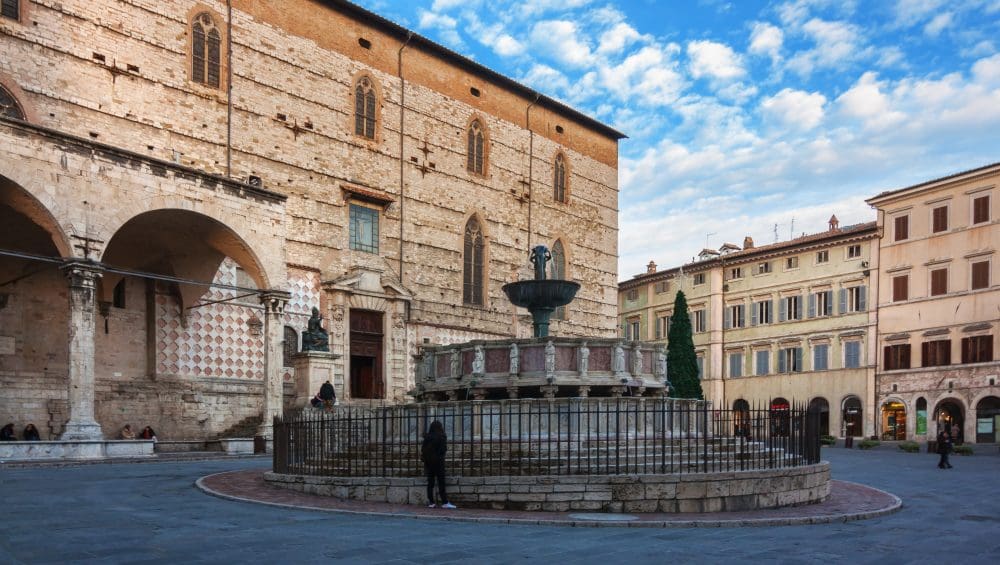“In Perugia one breathes grace, kindness and a kind of moral sweetness as if dissolved in the air. Inside the circle of the walls of Perugia there are signs of all centuries and of all styles, from the Etruscan to the neoclassical. Perugia is among the densest capitals of art” –
Guido Piovene, journalist and writer
With these beautiful words dedicated to Perugia, we kick off this new column: the cities to visit all in one go in one day!
Welcome to Perugia, the city of chocolate, of Jazz, of art, of fashion, of the millenary history of the Etruscans up to today.
The city on a “human scale” that you can easily visit on foot, strolling through the squares and alleys, admiring its breathtaking views and tasting the traditional specialties.
You are ready? Comfortable shoes and desire to photograph
You are ready? Comfortable shoes and desire to photograph
1. Piazza IV Novembre and the Fontana Maggiore
Let’s start immediately with the heart of the city, the Piazza as postcard symbol of Perugia, located at the end of Corso Vannucci, the main street which is nicely defined by the Perugians as the “vasca”, symbology with the pools of the swimming pools due to its long and the typical walk back and forth between boutiques, traditional and fusion restaurants, historical pastry shops, and chocolate shops. The Fontana Maggiore was built in Gothic style between 1275 and 1278 by Nicola and Giovanni Pisano: there are 50 engraved bas-reliefs and 24 statues representing the 12 months of the year with the main agricultural activities and the zodiac signs and with stories of the old and new Testament. The 24 statuettes are the representation of saints and mythological and biblical characters as well as the representation of the Griffin, the symbol of the city of Perugia.
A stone’s throw from the Fountain there is access to the Archaeological Excavation of Perugia Underground, a beautiful dive into the past walking through the Etruscan and then Roman streets.
Click here
2. Palazzo dei Priori
An elegant Gothic-style building with mullioned windows dating back to the 12th century. Today it is the seat of the Municipality and of the National Gallery of Umbria, which hosts the Perugino Exhibition until June 2023 for the 500th anniversary of his death, as well as masterpieces of Italian art from the Middle Ages to the 16th century. On the ground floor of Palazzo dei Priori there are also the Collegio del Cambio and the Collegio della Mercanzia along Corso Vannucci.
You could take advantage of a tasty chocolate tasting, an essential experience in the sweetest city in Italy.
Click here
3. Porta Sole
From here the panorama is breathtaking. Porta Sole is one of the 5 gates forming part of the ancient city walls of Perugia, and also one of the Medieval District of the Center.
Stop for a second and admire the panorama, the ancient walls still visible and the very suggestive long staircase of Via delle Prome which lead you directly to the Etruscan Arch.
Also mentioned by Dante in the Divine Comedy, in Canto XI of Paradise
«Between Tupino and the water that descends
of the hill elected by Blessed Ubaldo
fertile coast of high mountain hangs
hence Perugia feels cold and hot
from Porta Sole, and weeps for them in return
for heavy yoke Nocera with Gualdo
4. Etruscan Arch
Also known as the Arch of Augustus, it is another of the gateways to Perugia. Built in the 3rd century BC and remodeled in 40 BC by Augustus. Beautiful and imposing, it will leave you speechless.
5. Acquedotto
Now that I’ve made you walk downhill, it’s time to make you walk uphill, along the Aqueduct, but it’s an experience that you absolutely cannot miss in Perugia. The Aqueduct is in fact famous for its staircase which, however, does not change here, remaining still (Semicitation of Hermione in Harry Potter and the Philosopher’s Stone “Stairs like to change“)!
At the top, take a breath and turn around. The view of the ancient medieval aqueduct that supplied the Fontana Maggiore is beautiful.
6.Rocca Paolina and the Carducci Gardens
At this point you have returned to the Centre, a “vasca” in Corso Vannucci and you are on the opposite side of Piazza IV Novembre. Here you can rest in the Carducci Gardens on one of the benches overlooking the wonderful panorama of Umbria, you will admire the newly restored statue of Perugino.
You are then ready to descend under the Rocca Paolina, a fortress dating back to the 16th century and commissioned by Pope Paul III. Today it is a connection point between Piazza Partisan (where you will find the bus terminal and the parking lot) but also a beautiful historic place where art exhibitions and markets (like the Christmas ones) are set up.
An idea to experience Perugia between experiences and overnight stays?



